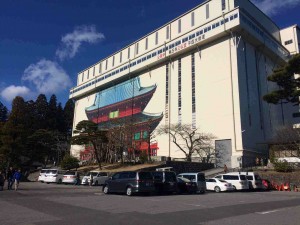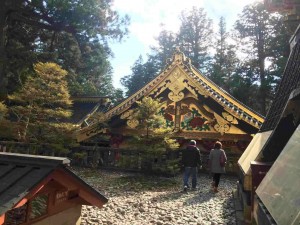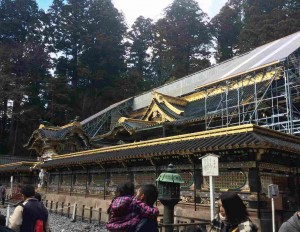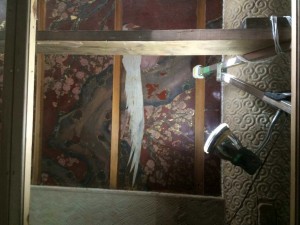On January 11th we took our class field trip up to Nikko, designated as a UNESCO World Heritage site with the national park as our main focus for the day. The park was very aesthetically pleasing to be in, and with a pretty park and a sunny day, t’was very crowded (the 11th was also national Coming of Age day, so anyone who had turned 20 in the past year dress up and make visits to the temples and shrines, so there were a few young women in kimono and men in suits).
We were told that one of the temples was under restoration and that there was a scaffolding around the building while they were repairing. As our group was walking up towards that temple, I saw a very large factory/warehouse-like building, an odd structure to have in a national park. There was a large picture of a temple on the front of the building, and it turned out that this very permanent-looking structure was the scaffolding around the temple, much bigger and sturdier then I had expected a scaffolding to be.
 But, as it was explained to me, there had to be a very secure structure around such an important building in case of an earthquake, which makes sense. We weren’t allowed to take pictures inside, unfortunately. We got to climb to the top of the building/scaffolding to look down on the restoration work being done. The entire top of the temple had been dismantled, as I could see aged beams set aside. There were workers installing new tiles in areas, perhaps replacing rotted beams in other places, necessary steps so that when the temple is put back together it will be able to stand for many more decades with these new additions.
But, as it was explained to me, there had to be a very secure structure around such an important building in case of an earthquake, which makes sense. We weren’t allowed to take pictures inside, unfortunately. We got to climb to the top of the building/scaffolding to look down on the restoration work being done. The entire top of the temple had been dismantled, as I could see aged beams set aside. There were workers installing new tiles in areas, perhaps replacing rotted beams in other places, necessary steps so that when the temple is put back together it will be able to stand for many more decades with these new additions.
We went further into the park towards Tosho-gu Shrine, mausoleum and burial site of Tokugawa Ieyasu, the 1st of the Tokugawa Shogunate. The buildings are extremely ornate, especially with so many detailed wood carvings and bright colors.
 In fact, parts of the shrine looked fresh and vibrant, as if they had been built only a short time ago, even though the shrine was initially built in 1617 and many of the buildings are hundreds of years old. As with the temple that was encompassed by the sturdy scaffolding, there were other buildings of the shrine that also had scaffolding (though not as sturdy) surrounding them for restoration work to keep everything in good condition.
In fact, parts of the shrine looked fresh and vibrant, as if they had been built only a short time ago, even though the shrine was initially built in 1617 and many of the buildings are hundreds of years old. As with the temple that was encompassed by the sturdy scaffolding, there were other buildings of the shrine that also had scaffolding (though not as sturdy) surrounding them for restoration work to keep everything in good condition.


So, to keep these national treasures standing, new material must be added over time to do so. The idea of “renewing the old with the new” came up again the next day, January 12th. That day we had a guest speaker, Mr. Eijiro Kawaii, from Chiryu Solar Heating. We learned about solar energy and the panels used to harness that energy. During the presentation he showed a slide that made me think of the reconstruction work I saw at Nikko. The slide said that on average, Japanese houses are taken down and rebuilt about every 30 years to make them new. A statistic he gave showed that 96.5% of houses in Japan are disposed/rebuilt, while the rest is due to earthquakes, fires, and tsunamis. Not what I expected. This is very different to how houses are treated in the U.S., where we try to keep the structure as original as possible, only doing updates to the house that don’t completely change the structure. I think that we think that (a mouthful, I know), keeping a structure as close to its original form makes it more authentic, therefore “better” since we can see and perhaps touch exactly the same things that our ancestors did. We’d usually rather let something slowly fall apart in its original form, with great effort to keep it as original as possible, with minimal new additions to keep things together, whether it be a 19th century farmhouse or a 1916 Harley-Davidson. But here in Japan, at least from what I have seen, there is value in renewing old things to keep them looking in the condition they were when first built, such as at Nikko. Perhaps that is to keep them in their “former glory”, a way for people of today to connect to their ancestors by being able to experience in person what these sacred structures were supposed to look like when they were first built.
These structures in this park are very culturally and historically important to Japanese citizens, so of course making sure the buildings are always in good shape is a huge priority. Being in an environmental sustainabilities class led me to wonder about some of the values that humans have. Just like here in Japan, around the world important human-made structures and other objects of historical and cultural significance are taken care of so that they may last a very long time for future generations to experience. I wonder why don’t we do the same for the environment that we live in (?). Shouldn’t the environment be treated just as highly as any UNESCO World Heritage site is? If we are willing to put so much effort into preserving human-made treasures, we should do the same for the environment/the natural world (though the definition of “natural” is a whole other discussion) since it is a precious treasure that we depend upon, and if there’s no careful thought put into how the environment can be preserved in a healthy form, it will eventually “fall apart” and we will go down with it. Not an uplifting thought, but it is true. Not that we shouldn’t put a great amount of effort into preserving important sites and objects, such as the monuments in Nikko, but environmental preservation needs to be given an equal, if not greater, amount of attention to keep it, and therefore us humans, healthy.

Recent Comments